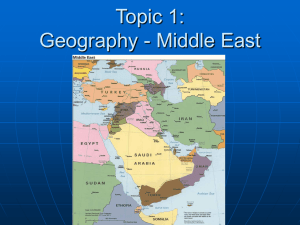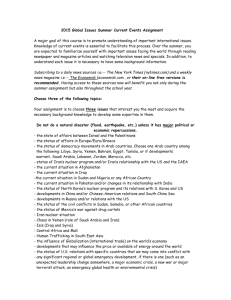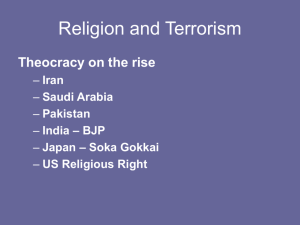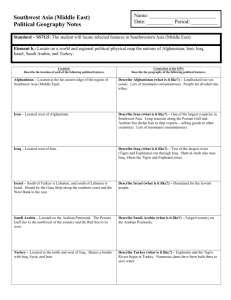What factors encourage change in the Middle East today?
advertisement
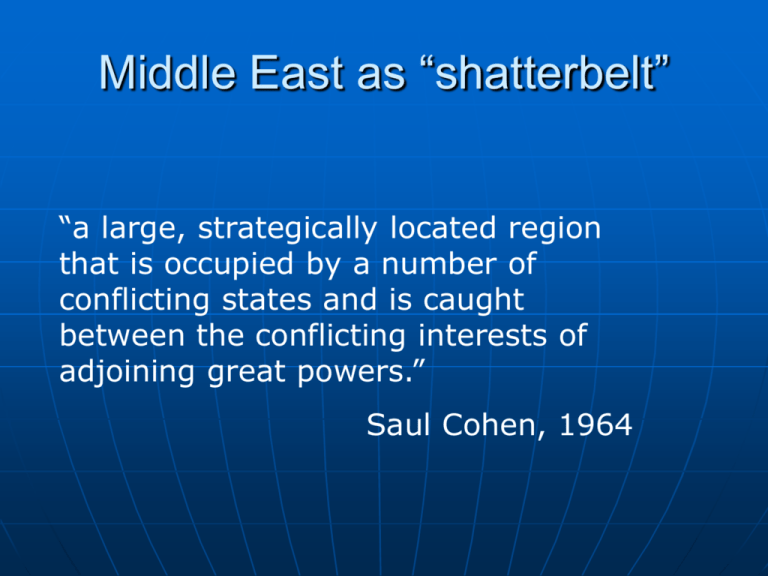
Middle East as “shatterbelt” “a large, strategically located region that is occupied by a number of conflicting states and is caught between the conflicting interests of adjoining great powers.” Saul Cohen, 1964 Modernizing States – Middle East Questions: Why aren’t more countries in the Middle East democratic? Can Middle Eastern countries modernize without becoming Western? Does economic liberalization lead to political liberalization? What factors encourage change in the Middle East today? What factors impede change in the Middle East today? Impact of WWI on the Middle East THE single most important political event in the history of the Modern Middle East per capita losses in Ottoman Empire and Persia greater than in Europe (25%) creation of the modern state system ideological glue binding these states was nationalism political transformation in Palestine The Middle East and the West End of the Ottoman Empire of Turkey Republic After WWI: mandate system in Gulf States: • Britain Palestine, Iraq, Transjordan • France Syria, Lebanon “Independent” by end of WWII but Western oil interests remained Cold War and competition for oil meant Middle East remained an area of Western intervention and influence Interwar Period pro-Nazi sympathies – Iran Egypt – “independence by degrees.” Muslim Brotherhood founded – 1928 non-Muslims continued to control many areas in the ME. oil discoveries lead to ARAMCO and other concessions. anti-imperialism and tension in ArabIsraeli dispute and in India/Pakistan World War II and its Impact Axis search for oil – Battle of el Alamein, 1942. British White Paper – “Palestine off limits to Jews.” Intensification of Arab-Israeli Conflict. Modernizing, “developmental ethos.” Revolts and Reforms Independence Modernizing Ideologies “Muslims did not march in single file” 1. 2. 3. 4. 5. Bourgeois Liberalism/Capitalism – secular, individualistic, democratic, market forces (Liberal modernization theory). Marxism – state control, command economy, secular. Islamism – traditional religious values, fundamentalism, conservative Arab Socialism-secular, anti-colonial, pan-Arab, cultural expression of identity? Nationalism – secular, ethnicity or loyalty to the state Which has your country attempted? http://www.mideastweb.org/maps.htm “Greater Middle East” Egypt-Nasser, Sadat, Mubarak – Arab Socialism and Pan-Arabism Iraq - Hussein-Baathist Socialism Syria – Asad – Baathist Socialism Libya – Qadafi – Green Socialism Turkey - Secular Republic Iran – Shah, Khomeini, Ahmadinejad –Islamism Saudi Arabia – “Family w/ Flags”, Wahabi Islam http://www.mideastweb.org/maps.htm Four Critical 20th c. Issues “There was no 20th c. in the Middle East” Domestic – social frustration, “defensive developmentalism,” oil is a curse Foreign Policy – constant intervention, how to control their own destiny Political Instability – questions of legitimacy, “top-down rather than bottom-up governments,” patron-client state Ideological confusion – cultural and moral debates Traditional Identities 1. Birth Identities: Blood = family, clan, tribe Place = neighborhood, village, district, province, country. Religion = may be the only one that transcends the others 2. Allegiance to a ruler – hereditary monarch What is a tribe? (“horde” in Central Asia) be aware of Eurocentric bias—more “primitive” type of social unit. “family resemblances”—shared customs, cultures, ideas—practical guide to social actions such as marriage, landholding, rights within the group. administrative units Tribalism “is not a single phenomenon rather, it is a persistent social and political force bringing together people for many different purposes.” • from Peoples and Cultures of the Middle East “I against my brother; I and my brother against my cousin; I an my brother and my cousin against the stranger” from an old Arab proverb Nationalism and Islamism Common Elements Both emerged because of similar historical conditions(imperialism) “While the strengthening of the one has led to the strengthening of the other, the failure of one has led to a surge in popularity of the other.” James Gelvin The Modern Middle East Both address similar concerns: -creating unity, Westernization - economic dependency political and cultural Both draw -political subjugation legitimacy from same assumptions: -corruption -adapted to the state system -returning to “the -cultural essence” authenticity -dignity Zones of Islam Arab – Egypt, Iraq, Syria, Lebanon, Libya, Kuwait, Yemen, Saudi Arabia, Gulf States Turkish - Turkey Persian - Iran South Asia – Pakistan and India Southeast Asian – Indonesia, Malaysia, Philippines African - Morocco, Tunisia, Sudan, Algeria, Nigeria Disapora Islam in politics Relaxed model – use Islam to legitimize the actual lived experiences today, “live and let live.” Reform model – use Islam to reform society, or co-opt Islam to serve rulers’ purpose. Revolutionary model – seek mass mobilization to bring back the age of purity and the creation of a new society. Political Islam-Fundamentalism “shadow side of modernity” – develops when modernization is well-established, so a reaction against it because: deep disappointment with modernity fear of secularism, liberalism and its values pushing religion from the sidelines back to the center begins as an internal dispute within own culture/country Ex. opposing westernizing leaders or policies return to a “golden age” – overstressing traditional values Ex. putting women back into veils a reactive form of modernism, often innovative and radical tactics: withdrawal from society forming separate communities fighting for survival revival of faith terrorism (minority) Egypt See ME, pp. 281-293 Egypt overcome tribalism and create a new identity – Arab nationalism reverse effects of imperialism – antiimperialism Arab socialism – Nasser, Arab League 1950’s Suez Crisis Muslim Brotherhood, Said Qutb Sadat – opening (intifah) to the West Mubarak – “dictatorship w/ a Western face” Iraq 1918-32 British rule • Even after independence Britain retained oil rights and kept military bases in Iraq Monarchy military rule Ba’thists 1979 Saddam Hussein took power Saddam suppressed opposition also Kurdish minority Iraq Iraq Mandate policy • “on paper, a good idea” • Mosul in the North,oil rich (Sunni Kurds) • Tigris/Euphrates/Baghdad, farmland (Shi’a and Sunni) • Basra in the South, oil potential, access to Persian Gulf • Sunni Faysal, from Hussein in Mecca, to rule, with British “support” over Shi’ite majority. • Frequent resistance Iraq Continued: after WWII, conflict and removal of monarch, Faysal. British pursue “divide and rule” policy. Hussein and Ba’athist Socialism • secular • nationalistic • Iraq’s Bismarck? (invasion of Kuwait) Saudi Arabia conservative Sunni Islam, Wahhabism “family with flags” Ibn Saud, Ikhwan large royal family rentier state due to oil welfare state Turkey See pp. 125-132 Turkey Six Arrows • republicanism – Ataturk • nationalism – Turkification • populism – social and educational changes • statism – strong military, central bureaucracy • secularism – no veil, co-opt clerics • reformism – Western alphabet, customs “Frontier Islam” – pro-European Iran Iran 1940s: Britain and USSR invaded to protect supply routes 1951: Mohammad Mossadeq, proponent of nationalizing oil, appointed Prime Minister 1953: Mossadeq overthrown by US and UK intelligence; installation of pro-Western Shah 1953-79: Iran closely allied with the U.S. Iran was highly secularized and Westernized Shah Muhammad Reza Pahlavi Iranian Revolution 1979 Revolution to overthrow the regime of the Shah Also a cultural revolution for “revolutionary Islam” 1979: Ayatollah Khomeini established Republic of Iran 2002 labeled by Pres. Bush part of “axis of 1979-81: 55 Americans were held hostage Iran now Final victor in IranIraq war? Nuclear ambitions? Broker of regional peace? President Mahmoud Ahmadinejad Upset or balance power vis á vis Israel? Iran Westernization – Pahlavi, Shah of Iran (White Revolution – 1960’s) Nationalism – Mossadiq in 1950’s Khomeini – Islamic Theocracy Iran a petrostate? Iran a nuclear state? Regional power? Why Turkey “succeeded” and Iran “failed”. . . greater resistance to development in Iran than in Turkey b/c Turkey started earlier, so not so strange. Kemal created government and state at same time; Reza Shah created government in already self-governing state. Kemal created state during war of national liberation; Pahlavi seized power in a coup. Pakistan See pp. 135-138, Pakistan Western Liberalism – Jinnah, founder of Pakistan, 1947 Bhutto – Zia – power of the military Islamic resurgence - madrasas Tribalism Musharraf/Bhutto – patron-client state “What makes 1998 quite different from 1898, and radically different from 1798, is the sense among Muslims that people in Malaysia are directly, immediately, and powerfully affected by what is happening in Sudan or Algeria or Pakistan.” (Humphreys, 146) “For it is often the way we look at other people that imprisons them within their own narrowest allegiances. And it is also the way we look at them that may set them free” (Malouf, In the Name of Identity) What determines your identity? http://www.occamsrazor.info/images/middle_east.jpg
